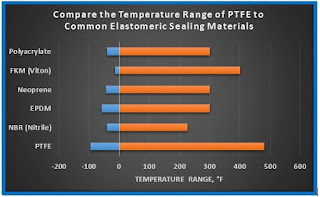Why use a PTFE (Polytetrafluoroethylene) instead of Rubber in a Rotary Shaft Seal?
PTFE Rotary Shaft Seals Outperform Rubber Shaft Seals
Elastomeric seals performed well for many years, but as the applications and environments became more demanding, elastomers had a hard time keeping up. If the application pressure is above 30 psi or the operating temperature goes above 275°F, elastomers simply don’t perform as well as, say, PTFE. (polytetrafluoroethylene). In this article, we are going to look at 3 areas where PTFE rotary shaft seals outperform rubber shaft seals.
Need more information on PTFE Rotary Shaft Seals? Check out these additional articles from the popular Advanced EMC Technologies Blog:
•Four Most Popular Rotary Shaft Seals Material Options and How They Compare
•Five Ways that PTFE Rotary Seals Differ from Elastomeric Seals
•Rotary Seals for Dummies: Four Questions about Shaft Surfaces for PTFE Rotary Seals
Wider Temperature Range
A major area that PTFE outpaces elastomeric seals is in its operating temperature range. As seen in the chart below, PTFE can function between -95°F to 480°F, far beyond any of its competitors in both cryogenic and high temperature applications.
Lower Friction
Friction generates heat, and heat buildup can be catastrophic to seals – resulting in unpleasant things like cracks or melting. PTFE has the lowest coefficient of friction of any solid material currently known, which is much lower than that of the elastomers typically used for seals. PTFE can also be used for dry running (i.e., without needing a lubricant), which elastomers cannot.
Better Chemical Resistance
PTFE is known for its chemical compatibility and excellent performance even in the presence of some of the most caustic chemicals out there. Rubber, however, has some limitations.
For example, Viton (FKM) is susceptible to ketones and acetones. EPDMdoesn’t perform well many oils and fuels, as well as hydrocarbons and concentrated acids. Nitrile (NBR) doesn’t do well in the presence of ozone, acetone, esters and ethers, or methyl ethyl ketone. Polyacrylatedoesn’t get along well with alkalines. In addition, elastomers aren’t really compatible with water, either.
Higher Speed Applications
As shown in the chart below, PTFE is the number one choice for high speed seal applications. In order or performance from low speed to high speed, we see Nitrile, Polyacrylate, and FKM (Viton).

